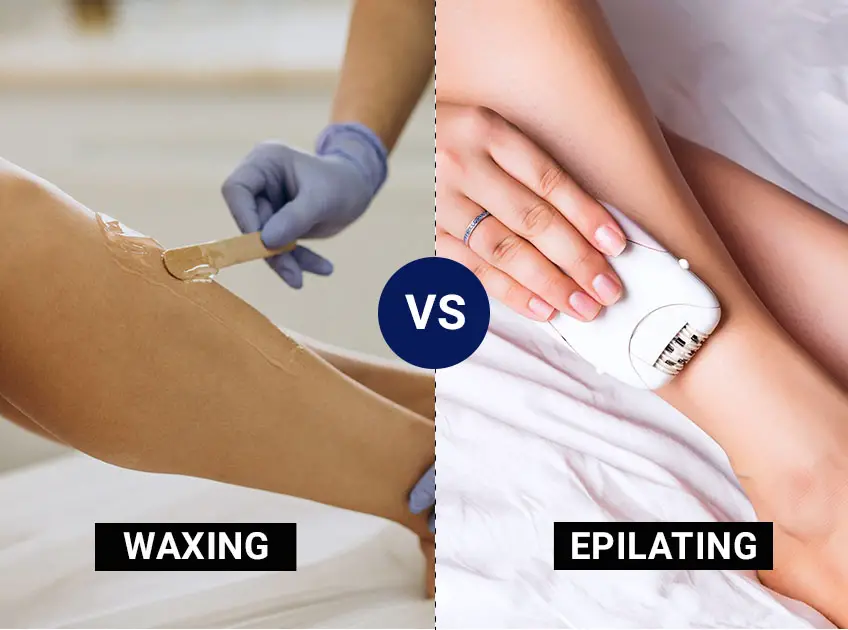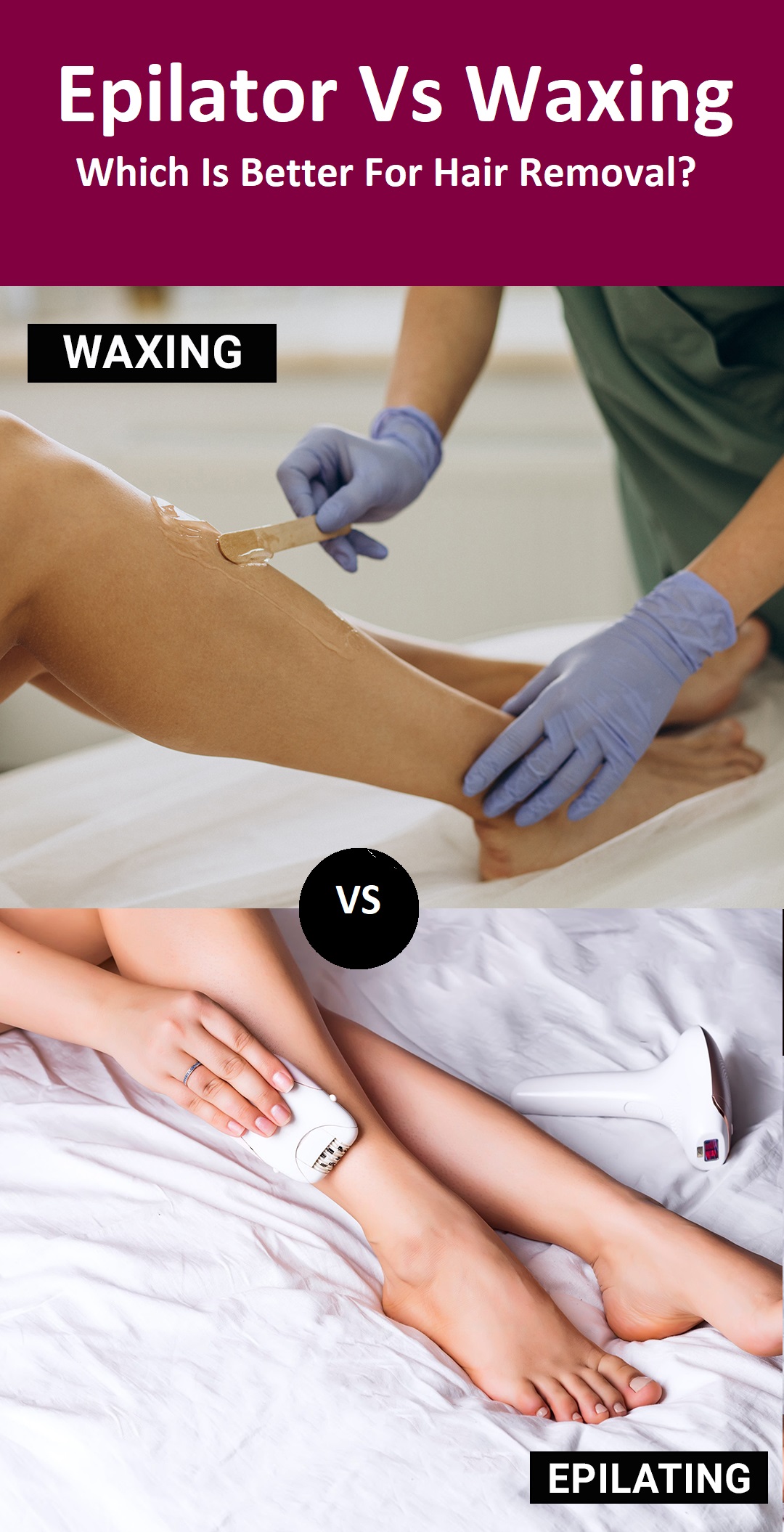
Important: This article is for informational purposes only. Please read our full disclaimer for more details.
When it comes to hair removal procedures, waxing and epilators are considered the most efficient. With the ability to remove hair from the root, these two methods are equally good. However, a few differences make them, like chalk and cheese.
Waxing involves using warm wax and stripes to pull off the hair rapidly, and epilation involves using an electric machine called an epilator.
Let’s dig a little deeper and know the similarities and differences between the two.
Epilator Vs Waxing
1. The Process
Epilation

In epilation, a mechanical device called an epilator is used. You have to glide this machine in the direction of your hair, and as it moves, the hair is plucked by the roots. Epilators can be used in wet and dry body parts, and they don’t require any other substance like wax.
Waxing

In waxing, wax is heated, and a layer is applied to the skin in the same direction of hair growth. The next step is to apply a thin and soft waxing paper strip over the wax and remove it quickly against the direction of hair growth. Some people use hard wax, which needs to get hardened before removing the strip of the wax itself against the direction of hair growth.
2. Best-suited Areas
Epilators- It works best for larger areas like arms and legs. Though it can be used in sensitive areas, like the underarms and bikini area, as it hurts, everything depends on your pain tolerance.
Waxing- Wax is applied precisely to the areas where hair removal is needed. It can work on every body part, including the face, bikini area, and torso. Waxing is equally painful and depends upon your pain tolerance. However, its results are long-lasting, especially in sensitive areas.
3. Benefits
Epilator- The most promising benefit of an epilator is its ability to remove shorter hair that waxing cannot. Using an epilator will ensure the smoothest and closest hair removal results.
Waxing- In waxing, the wax adheres to the top layer of the skin, and as it is pulled with a waxing strip, the dead skin cells also come out. Thus, it provides mild exfoliation as well. These are the major differences between waxing and epilators regarding benefits. The results of both these methods are long-lasting compared to other methods like shaving. At the same time, you can perform both these processes at home with the help of the right tools and techniques. On the contrary, a few hair removal techniques, like laser hair removal, are in-office treatments.
4. Side Effects
Even though both these methods are safe and effective, people may experience certain side effects depending on their skin’s sensitivity. Also, both are painful compared to shaving and using hair removal creams.
Epilators- It is like tweezing, so the skin may feel tender to the touch. You may also experience-
- Redness
- Bumps
- Irritation
- Ingrown hairs
Waxing- Waxing involves pulling the hair with force, so it can also distress the skin. Some common side effects of waxing include-
- redness
- irritation
- rashes
- bumps
- sun sensitivity
- allergic reaction
- infection
- scarring
- burns
- ingrown hairs
Even though the side effects of epilators are fewer than waxing, it largely depends upon the skill level of the person doing it and how used the skin is for the process.
5. Precautionary Measure
People with highly sensitive skin who cannot tolerate pain should opt for painless hair removal methods, like shaving and using hair-removing creams. Besides, you should not opt to wax if you are on certain medications like Also, waxing is not a good choice for people undergoing radiation treatment like chemotherapy. Also, waxing is not a good choice for people undergoing radiation treatment like chemotherapy.
- certain antibiotics
- hormone replacement therapy
- hormonal birth control
- Accutane
- Retin-A or other retinol-based creams
Also, waxing is not a good choice for people undergoing radiation treatment like chemotherapy. They should prefer epilation.
6. Level Of Pain
It won’t be an exaggeration to say that none of these methods are most comfortable. Waxing and epilation pain fairly; however, it depends on the pain tolerance level and how frequently you are undergoing them. People who often epilate or wax tends to feel less pain over time. However, if you are new to any of these methods, be ready to experience pain as the hair comes out of your dermis.
7. Results
Since waxing and epilation deliver long-lasting results, you probably won’t need to perform them frequently.
Epilator- As an estimate, epilation results last 3 to 4 weeks. Some believe that the longer you do it, the slower you notice the hair growing back. The best thing is you can epilate short hair successfully, and they need to be at least 1/8 inch long as in waxing.
Waxing- The result of waxing also lasts for 3 to 4 weeks. If your hair grows back slowly, it can last even longer. It is believed that if you wax consistently, the hair growth slows down and comes out less dense. However, before you go for another waxing session, your hair must be at least 1/4 to 1/2 inch long. Wax doesn’t adhere well on short hair, and the hair doesn’t come out with pulling.
Final Words
While waxing and epilator both produce similar and consistent results, what you like the most depends upon your personal choices. Waxing may seem messy and untidy to many and epilation more painful. If your skin is highly sensitive to pain, epilation may not be the best for you. On the contrary, if you look at the side effects, epilation seems safer than waxing. Experiment a little and choose what you feel is the best for you.
You Might Also Like
- How to Use Baking Soda for Hair Removal?
- How to Remove Facial Hair Naturally: 13 Best Methods to Try
- How to Remove Facial Hair with Egg White?
- How to Remove Facial Hair With Turmeric?
- How to Wax Your Legs at Home
- Does Waxing Help With Ingrown Hairs?
- 5 Best Nose Wax Kit For Hair Removal
















